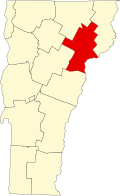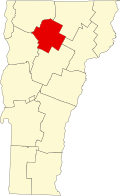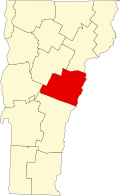List of counties in Vermont
Appearance
| Counties of Vermont | |
|---|---|
| Location | County government |
| Subdivisions |
|
There are fourteen
, often referred to as a "shire town."In 1779, Vermont had two counties. The western side of the state was Bennington County and the eastern was
Cumberland County.[1]
In 1781, three new counties (including then-called Washington that became part of New Hampshire) were created out of Cumberland County, and the remainder of the county was renamed Windham.
Today's Washington County was created in 1810 as Jefferson County
; it was renamed Washington in 1814.
Essex County, Orleans County, and Caledonia County are commonly referred to as the Northeast Kingdom.
The FIPS county code is the five-digit Federal Information Processing Standard (FIPS) code which uniquely identifies counties and county equivalents in the United States. The three-digit number is unique to each individual county within a state, but to be unique within the entire United States, it must be prefixed by the state code. This means that, for example, while
FIPS County Code are to the Census Bureau Info page for that county.[2]
List
| County |
FIPS code[2] | Shire town[3] | Est.[3][4] | Origin[5] | Etymology[5] | Population[6] | Area[3][7] | Map |
|---|---|---|---|---|---|---|---|---|
| Addison County | 001 | Middlebury | Oct 18, 1785 | Part of Rutland County. | Joseph Addison (1672–1719), an English politician and writer. | 38,047 | 770 sq mi (1,994 km2) |

|
| Bennington County | 003 | Manchester |
Feb 11, 1779 | One of the original two counties. | Benning Wentworth (1696–1770), the colonial governor of New Hampshire (1741–1766). | 37,039 | 676 sq mi (1,751 km2) |

|
| Caledonia County | 005 | St. Johnsbury | Nov 5, 1792 | Part of Orange County. | Latin name for Scotland. | 30,535 | 651 sq mi (1,686 km2) |

|
| Chittenden County | 007 | Burlington | Oct 22, 1787 | Part of Addison County. | Thomas Chittenden (1730–1797), first governor of Vermont (1791–1797). | 170,851 | 539 sq mi (1,396 km2) |

|
| Essex County | 009 | Guildhall | Nov 5, 1792 | Part of Orange County. | Essex, a county in England. | 6,037 | 665 sq mi (1,722 km2) |

|
| Franklin County | 011 | St. Albans (city) | Nov 5, 1792 | Part of Chittenden County. | Benjamin Franklin (1706–1790), one of the most revered Founding Fathers of the United States. | 51,066 | 637 sq mi (1,650 km2) |

|
| Grand Isle County | 013 | North Hero | Nov 9, 1802 | Part of Chittenden County and Franklin County. | Largest island in Lake Champlain. | 7,528 | 83 sq mi (215 km2) |

|
| Lamoille County | 015 | Hyde Park (town) | Oct 26, 1835 | Parts of Chittenden County, Franklin County, Orleans County and Washington County. | La Mouette (meaning the seagull), named by French explorer Samuel de Champlain (~1570–1635) but mistranscibed as La Mouelle and eventually corrupted to current spelling. | 26,248 | 461 sq mi (1,194 km2) |

|
| Orange County | 017 | Chelsea | Feb 22, 1781 | Part of Cumberland County. | Prince William (1650–1702) of Orange. | 30,050 | 689 sq mi (1,785 km2) |

|
| Orleans County | 019 | Newport (city) | Nov 5, 1792 | Part of Chittenden County and Orange County. | City of Orléans, France. | 27,726 | 697 sq mi (1,805 km2) |

|
| Rutland County | 021 | Rutland (city) | Feb 22, 1781 | Part of Bennington County. | Town of Rutland, Massachusetts. | 60,198 | 932 sq mi (2,414 km2) |

|
| Washington County | 023 | Montpelier | Nov 1, 1810 | Parts of Orange County, Caledonia County, and Chittenden County. Renamed from Jefferson County to Washington County on November 8, 1814 | George Washington (1732–1799), first President of the United States (1789–1797). | 59,844 | 690 sq mi (1,787 km2) |

|
| Windham County | 025 | Newfane | Feb 22, 1779[a] (as Cumberland County) (renamed 1781) |
One of the original two counties. | Town of Windham, Connecticut. | 45,627 | 789 sq mi (2,044 km2) |

|
| Windsor County | 027 | Woodstock | Feb 22, 1781 | Part of Cumberland County. | Town of Windsor, Connecticut. | 57,697 | 971 sq mi (2,515 km2) |

|
See also
- List of cities in Vermont
- List of gores in Vermont
- List of towns in Vermont
- List of former United States counties
Notes
- a There are several sources that state the formation year for Windham County is 1781 and that Cumberland County was dissolved rather than renamed.[8]
Further reading
- writer, Statf (2022). "VERMONT COUNTY GOVERNMENT OVERVIEW" (PDF). ce.naco.org. National Association of Counties (NACo). Retrieved January 3, 2025.
References
- ^ "Vermont County Information". Genealogy Trails. Retrieved July 22, 2007.
- ^ a b "EPA County FIPS Code Listing". EPA. Archived from the original on August 17, 2009. Retrieved July 22, 2007.
- ^ a b c "NACo - Find a county". National Association of Counties. Retrieved February 24, 2012.
- ^ "Vermont County Creation Dates and Parent Counties". www.familysearch.org. Retrieved June 8, 2023.
- ^ ISBN 0-8108-5036-2. Retrieved September 11, 2016.
Origins of County Names.
- ^ "Vermont QuickFacts". U.S. Census Bureau. Retrieved March 14, 2025. (2024 Census estimate)
- ^ "Vermont QuickFacts". U.S. Census Bureau. Retrieved September 11, 2016. (2010 Census)
- ^ "Vermont: Consolidated Chronology of State and County Boundaries". The Newberry Library. 2008. Archived from the original on February 24, 2012. Retrieved June 3, 2009.

